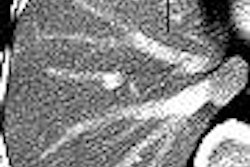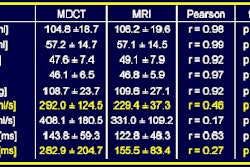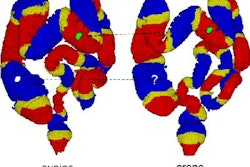Gadolinium-based contrast agents, usually reserved for MR imaging, can provide diagnostic CT angiograms of pulmonary circulation with 16-detector-row CT, and can be used as an alternative to iodinated contrast in patients with contraindications for iodinated agents, according to researchers from France.
"The doses of 0.3 and 0.4 mmol/kg were found to be well-tolerated, even in patients with underlying renal insufficiency," researchers from the University of Lille reported in Radiology (June 2005, Vol. 235:3, pp. 819-826).
The study prospectively evaluated 37 patients, 27 with allergic reactions to iodinated contrast and 10 with impaired renal function, for suspected acute pulmonary embolism in some cases and for management of tumoral disease in others. Nineteen patients underwent CT angiography with four-detector-row CT (Sensation 4, Siemens Medical Solutions, Erlangen, Germany) and 18 with 16-detector-row CT (Sensation 16, Siemens).
Gadolinium did not cause any adverse events in the patient group on clinical and biologic follow-up except in one patient with preexisting moderate chronic renal failure. The patient showed significant but transient reduction of creatinine clearance after contrast injection. The creatinine clearance returned to baseline values within three days, the researchers stated.
Better images with 16-detector-row CT
Thirty of the CT angiograms were graded as diagnostic and seven as nondiagnostic. The number of diagnostic angiograms was higher in the group in which 16-detector-row CT was used. In this group, 17 of the 18 angiographies were diagnostic, compared to 13 of 19 angiographies in the group in which four-detector-row CT was used (p = 0.007).
Attributing this to the higher level of pulmonary artery enhancement, "the rapidity of data acquisition available with a 16-detector-row CT is the major determinant for such an improvement in image quality," the researchers stated. The images were rated as excellent, good, or poor, and graded as diagnostic if they were excellent or good, and nondiagnostic if they were poor.
Excellent image quality meant that peak CT attenuation within the pulmonary arteries was greater than 150 HU, with constant enhancement from top to bottom of the scanned volume. Good image quality was 100-150 HU. The image was rated poor if the peak CT number was less than 100 HU, or if a gradient of arterial enhancement was observed in the scanned volume.
Comparing the findings of the group in which 16-detector-row CT was used (group 2) with those of the group in which four-detector-row CT was used (group 1), the researchers noted that "the level of maximal enhancement in the pulmonary arteries was significantly higher in group 2 than in group 1 (215.8 HU ± 95 versus 141.3 HU ± 44) (p = 0.02) and was maintained throughout the entire region of interest in a greater number of examinations in group 2 than in group 1 (n = 16 [89%] versus n = 2 [10.5%]) (p < 0.0001)."
The region surveyed extended from the level of the aortic arch to the level of the inferior pulmonary veins. Z-axis coverage was reduced to the middle third of the thorax, given the limited volume of gadolinium that could be administered even at maximum level.
The mean duration of data acquisition was significantly shorter in group 2 than in group 1 (4.4 seconds versus 7.6 seconds, p < 0.001). According to the researchers, the speed of the 16-detector-row CT also made it possible to use an automatic bolus triggering program for group 2 patients. In the group 1 patients, the start delay in the four-detector-row CT had to be empirically chosen.
Inadequate selection of the scanning delay -- scanning delay was too short in 10 group 1 patients and too long in seven group 1 patients -- caused the gradient of the arterial enhancement observed in all but two patients in group 1, the researchers said.
Gadolinium dose
Patients in both group 1 and group 2 were randomly assigned 0.3 or 0.4 mmol/kg of gadolinium by injection of 0.5 mmol/mL gadopentetate dimeglumine (Magnevist, Schering, Berlin). Nine patients in both groups received a 0.3 mmol/kg dose, and 10 in group 1 and nine in group 2 received 0.4 mmol/kg dose.
"No statistically significant difference was found in the mean volume of gadolinium administered nor in the mean start delay between group 1 and group 2," the researchers wrote. "This preliminary clinical experience in a population of 37 patients suggests that gadolinium-based contrast media are well-tolerated even in patients with underlying renal insufficiency, when gadolinium is administered at doses of 0.3 or 0.4 mmol/kg."
Despite administration at a rate of 6 mL/sec, patients reported the exam as painless and there was no extravasation at the administration site. The choice of the 6 mL/sec flow rate was decided based on findings in published literature showing that a gadopentetate dimeglumine concentration of 0.5 mmol/mL resulted in approximately the same attenuation as iodine contrast at 150 mg/mL. And that 120 mg/mL of iodinated contrast administered at 6 mL/sec had good to excellent vascular enhancement, the group reported.
The scanning parameters for CT angiography with the four-detector-row scanner were 120 kV, 60-100 mAs, 0.5-sec rotation time, 1-mm section collimation, and a pitch of 2 with a reconstruction of 2-mm thick scans. For the 16-detector-row CT, the scanning parameters were 80-120 kV, 70-120 mAs, 0.5-sec rotation time, 1.5-mm collimation, and a pitch of 1.5 with reconstruction of 2-mm thick scans. CT angiography was preceded by nonenhanced CT over the thorax for a complete chest exam.
The study was supported by Schering, and the power injector (Spectris, Medrad, Pittsburgh, PA) was provided by Medrad for injection of the contrast agent followed by a saline flush.
"High-quality gadolinium-enhanced CT angiograms require the use of 16-detector-row CT technology; the doses administered did not alter the renal function except transiently in one patient," the researchers concluded.
By N. Shivapriya
AuntMinnie.com contributing writer
July 12, 2005
Related Reading
CTA seen as accurate complement to invasive angiography, May 24, 2005
Widen that search: CTPA reveals more non-PE than PE diagnoses, May 18, 2005
Noncoronary findings often identified on CT coronary angiography, May 18, 2005
Multidetector CT angiography identifies stable carotid plaques, January 12, 2005
Faster exam time gives CTA a leg up on MRA for peripheral vascular disease, January 19, 2005
Copyright © 2005 AuntMinnie.com



















